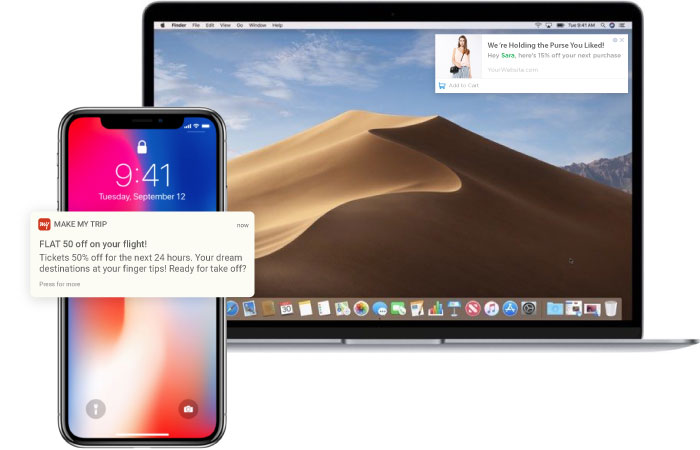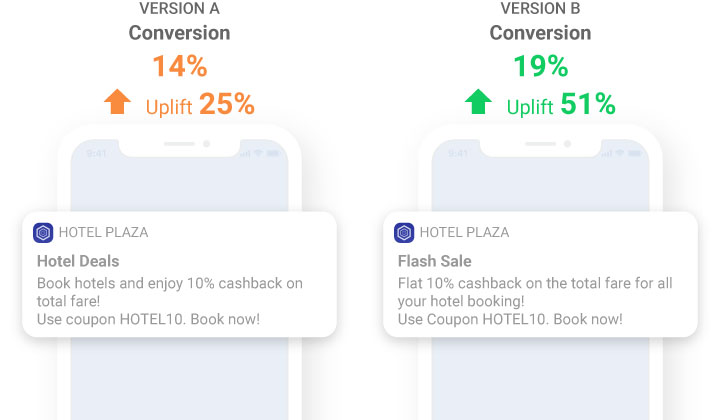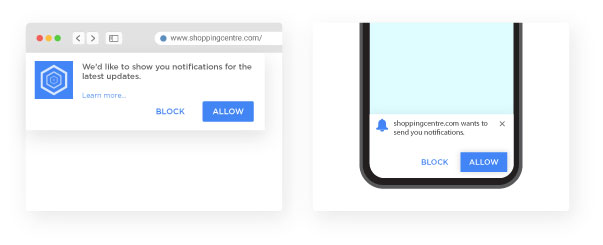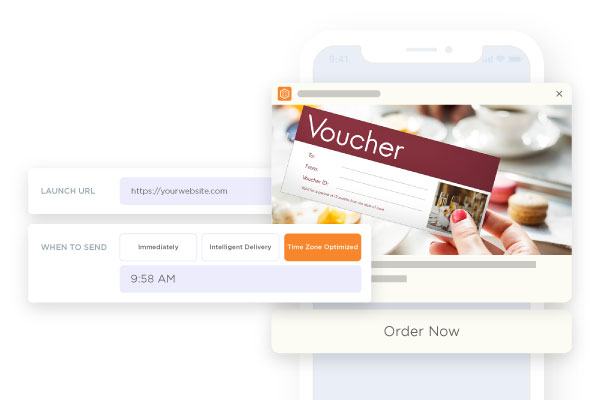Today, there is no wonder that brands focus more on efforts and funds on sustaining relationships with existing customers who regularly purchase their goods and services. But it does not mean that you shouldn’t make efforts to market your brand to new customers. They are also vital. Therefore, you consistently seek to re-engage them.
Contents
What are the advantages of customer re-engagement?
- Low Cost Of Acquisition: The cost of obtaining new customers is five times more than retaining existing customers.
- Higher ROI: We now understand the behavior of the existing customer or visitor. We have precise data of their activities. It enables us to make targeted and personalized action that leads to a higher conversion rate.
- Bettered CLTV: In the long run, engaged customers provide more business to the company than a regular customer. So it would help if you kept re-engaging customers; it will improve the customer lifetime value.
What is a push notification?

Push notifications are popup messages that you get on your desktop or mobile browser. These notifications allow a brand to engage with a customer even when they’re not utilizing the website.
Push notifications are supported on Chrome, Firefox, and Safari browsers, including Chrome browser kiosk mode, and you will receive them on your browser only after you give consent or subscribe to them.
Click here for elaborative guide on push notifications
Why use push notifications for customer re-engagement?
Push notifications are those notifications that are sent at the right time and provide value to the subscriber, lower cart abandonment, and boost conversions for the e-commerce brand.
According to a study, it costs 5x more to bring a new customer than to keep an existing customer. You can calculate all the money, time, and effort you have to spend in enticing a new customer who’d visit your store once and then never shop again.
On the other hand, according to research by Bain & Company, if you improve the customer retention rate by even by 5%, then you can boost your profits by between 25% and 95%,
There are many ways to re-engage customers. One of the most convenient ways is for re-engage customers is by applying web push notifications.
Why should you utilize push notification for customer re-engagement?
- Ease: Customer Re-engagement doesn’t require to be tough. Push Notifications are quite easy to install and use.
- Higher Subscription Rate: To re-engage your visitors, all you want your visitors is to subscribe to your website. Push notification helps you get a higher subscription rate than any other channel.
- Cost: The cost of customer re-engagement is the lowest when we compare it with the other channels.
How to leverage push notifications for customer re-engagement?
1. Craft a compelling message

You just have between 40 and 120 characters to give your message with push notifications. With such confined screen space, it’s essential to choose the most critical value proposition and write the text as precisely as possible. For instance, does your message give value to the subscriber? If your answer is affirmative, the subscribers’ browser’s push notification will have a greater click-through.
Combining social proof with the browser push notification is a different way to improve the click rate. For instance, if you host any event, your copy could be: “Over 500 marketers have already enrolled for the Summit.” If you require subscribers to click on a blog, you can mention: “This article has 500+ shares on LinkedIn.”
Essential pointers to understand while writing the web push notification copy are:
- Draft a catchy title with a brief copy. Your subscribers do not spare more than a few seconds to glance at the notification.
- Have a conversational tone.
- Use impressive one-liners and an actionable CTA.
- Write in easy language that directly conveys the idea of the notification.
- Personalize the message based on the users’ interests as it makes them three times more likely to transform.
- Make sure that the description should be in sync with the title.
- The edges should not get trimmed.
To give a hit shot, you can conduct A/B testing to figure out what kind of copy works the best with your audience.
2. Multichannel strategy

Marketers are practicing a multichannel approach for re-engaging with users. For instance, while push notifications allow a three-times higher reach for cart abandonment than emails, 70% of consumers research three or more channels before buying.
After giving a real-time discount on their browser with a push notification, you could send them an email a few hours later.
Shopping websites apply this approach and send out transactional information through push notifications as well as through email. Even If the user misses out on the push notifications, the email does the job, improving the chances of conversion.
3. Using push single-step opt-in

The first step to executing a push notification is to ask for approval from the user to send the push notification from the browser. The opt-in dialogue box requires the users to give permission. Also, make sure that you do not get too pushy.
Once the potential user clicks on the “block” or declines the subscription, they’ll nevermore see your pop-up again. But if done precisely, you can achieve push single-step opt-in can a subscription rate as high as 20%.
Keep in mind that asking customers to opt-in too early is the biggest mistake done by marketers. An additional method is to display the opt-in banner as a response to the user’s action. In other words, discover the right time to showcase the pop-up. For instance, if you have an e-commerce store, utilize push notifications to inform the user about the status of an order.
4. Send only relevant notifications
Just because sending a push notification is more convenient and more straightforward than sending an email, it doesn’t indicate that you should use them aggressively. Visualize the impact a push notification would have when you run a flash sale on your website and send the price drop alert.
Simultaneously, by sending a price drop notification about all products, the user will be irritated. It may lead to unsubscribing notifications.
Convey a message only when it requires the immediate attention of the user. Do not forward messages when you have nothing important to share.
The frequency and quantity of your notifications also depend on:
- The kind of users you are targeting. Are they frequent buyers or leads?
- What purpose does your notification serve? Is it for building awareness about your product, or are you retargeting users who have not bought for a while?
- Which business are you targeting? The frequency differs for e-commerce vs. games vs. travel vs. fitness and news.
Determining these details will assist you in personalizing the number of push notifications.
5. GDPR compliance

With the accomplishment of strict privacy laws like GDPR, it becomes necessary to ask for permission before forwarding any push notification.
The subscriber has to click on “Allow”; only then will they be forwarded notifications. So, technically, only when a user consents to the push notifications can the company collect their web push subscriber id.
6. Make your CTA Visible

CTA is the most vital part of your push notification. You have to ensure that every push notification has a CTA that implies the next action. The call-to-action should be noticeable and intrigue the user to perform the action indicated by the notification.
Some examples of clear CTA’s are:
For free trials: If you’re giving a free trial, these phrases have a higher conversion rate:
- Try for free
- Start my free trial
- Click to get a gift
- send me a gift
For benefit: Your CTA can confer the benefit. Some approaches to get started are:
- Book a consultation
- Download the e-book
- Show the code
- Send the discount voucher
7. Build a broad campaign
Make sure that you segment your subscriber list before sending out the push notifications. For example, building a “batch and blast” campaign won’t serve as your consumers look ahead to a personalized experience according to their choices. Instead, behavioral push notifications generate maximum relevance for the recipient.
According to a study employing segmentation in web push notifications, the Click through rate (CTR) could rise from anywhere between 100% to 218% across e-commerce, media telecom, search, and deal websites.
You can segment the subscribers based on:
- Time-zones they reside in
- Buying history
- Geo-location
- Browsing habits – whether they are cart abandoners or purchase
- Traffic source – direct or referral
- Type of the browser – Chrome, Firefox or safari
- Type of visitor – frequent or occasional
Based on these sections, you can forward push notifications regarding price drops, flash sales, live scores, a new blog post uploaded, change in the flight status, and weather forecast.
8. Deliver messages at the right time

As a business owner, you would desire to engage with your users at the right time. As the push notifications are conveyed in real-time and not stored anywhere, sending them at the wrong time can lead to:
- Your users may find you interfering
- Low open and view rates
- The user may unsubscribe from your notifications
While different studies show, different ideal times, there is no best-fixed time to send push notifications. Instead, the ideal time differs depending on multiple factors such as the time zone, geography, buying habits, website browsing, and purchase history.
The best practices to keep in mind while deciding the timings of your push notifications are:
- Get a decent idea about your user’s routine. For instance, informing your customers about a happy hour at 4-5 pm is much more productive than sending them a push notification about this offer at 8 is.
- Watch the time zone of the geography your subscriber lives in to ensure that the notification is not interfering.
Remember when your users are the most active to get a tremendous response from them regarding engagement and click-through.
Final Thoughts
Push notifications confer instant information even when the user is not on your website. The effectiveness is more reiterated because they further re-engage with existing customers with the right offers.
All these techniques mentioned above let brands utilize push notifications as a part of their user-engagement approach.
Read more:
- An Elaborative Guide on Push Notifications
- 5 Preparations You Should Make Before Using Push Notification
- 15 Best Push Notification Software & Tools in 2022 {Compared}
- How Web Push Notifications are Effective Than Other Marketing Mediums?

























 Email
Email SMS
SMS Whatsapp
Whatsapp Web Push
Web Push App Push
App Push Popups
Popups Channel A/B Testing
Channel A/B Testing  Control groups Analysis
Control groups Analysis Frequency Capping
Frequency Capping Funnel Analysis
Funnel Analysis Cohort Analysis
Cohort Analysis RFM Analysis
RFM Analysis Signup Forms
Signup Forms Surveys
Surveys NPS
NPS Landing pages personalization
Landing pages personalization  Website A/B Testing
Website A/B Testing  PWA/TWA
PWA/TWA Heatmaps
Heatmaps Session Recording
Session Recording Wix
Wix Shopify
Shopify Magento
Magento Woocommerce
Woocommerce eCommerce D2C
eCommerce D2C  Mutual Funds
Mutual Funds Insurance
Insurance Lending
Lending  Recipes
Recipes  Product Updates
Product Updates App Marketplace
App Marketplace Academy
Academy

